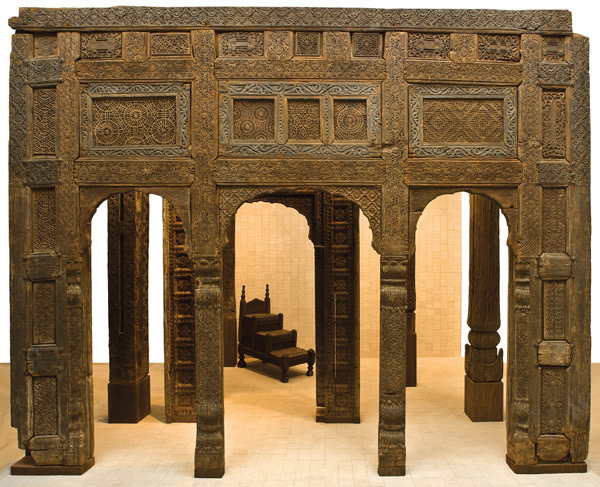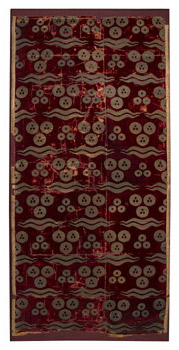This imposing room (54 x 14 x 6 m) is an extension of the temporary exhibition entitled «Art of Islam in the Belgian collections», organized for the Cinquantenaire from 5 December 2003 to 25 April 2004, that had allowed the Royal Museums of Art and History to show their riches in this field. A survey carried out among the public and the guides of the educational and cultural services contributed to define precisely the concept of the room. In a new, splendid venue, designed by architects Anne Pire and Jan Goots, it hosts 340 of the 1200 objects from the collection (not to mention the thousands of shards from Fustat and the nearly 200 weapons momentarily stored at the Musée de l'Armée).
Richness in textiles…
These objects, carefully selected and especially restored for this event, cover a wide territory, from Southern Spain up to Northern India. The most famous ensemble is the one of the textiles, made up for the greater part from the donation and bequest of Isabella Errera (1869-1929). It includes above all the Egyptian textiles from the beginning of the Islamic period and, among its masterpieces, a linen qamis (shirt with silk embroidery) dated between 1150 and 1230. Then come the Andaluzan and Sicilian silks, among them a superb Sicilian weaved-tapestry from the XIth-XIIth century with gold silk threads; Turk silk weaved cloths (with, in particular, a fragment from the çatma, probably the most ancient Turkish velour in the world) then the Iranian textiles and those from central Asia, with its lampas that look like miniatures.
… and other masterpieces
The collection also includes ceramics that cover the period from the IXth to the XIXth centuries - Sassanian ceramics, glossy ceramics from Kashan, tiles from Iznik as well as a pair of unique Armenian pieces from Kütaya. In the collection of ancient glass, we can note an enameled glass tumbler from the end of the Ayubbide period or from the beginning of that of the Mameluks. Metal objects, the art of stonework, miniatures and books are also represented. Decorative wood fragments from a small mosque in North-Western Pakistan, as well as three columns from the same region, acquired by the Royal Museums of Art and History between 1992 and 1996, are set up in the room to form an ensemble that will be one of the highlights of the presentation
Two levels of understanding
This is a diversified but ill-assorted collection, given the fact at it was made a little late, and that certain elements are lacking: Indonesia, the largest Islamic country in the world, is not represented. Furthermore, the pieces assembled were made for a small sector of the population: the sovereigns, the merchants or the urban bourgeoisie. Therefore, while it offers a rich insight, the collection does not pretend to represent Islam in its totality. An extension of the former room of the Near-East, to which it is linked by the architrave of Zebed - a masterpiece that bears the oldest Arab inscription in the world -, the room is organized according to two criteria. On the lower floor, the exhibition is carried out by region and by period, in seven different cells. On the mezzanine, themes are presented alternately. This first exhibition, entirely made up pieces from the collection, studies life in the desert, in a village and in a town. Videos, interactive stations and a game for children add a different, additional lighting to the objects shown.
PUBLICATION:
The catalogue in preparation will be available by mid 2009
Illustration: Velvet with çintanami design. Bursa(Turkey), second half of the 15th century- Silk and gold thread.
To see more illustrations, click on VERSION FRANCAISE at the top of this page
| 








